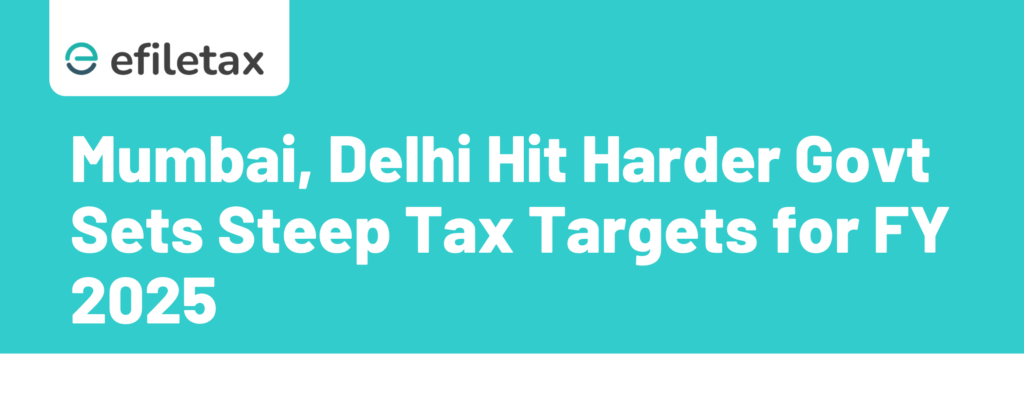
Mumbai & Delhi Face Higher Direct Tax Targets: A Wake-up Call for Taxpayers
The CBDT has reportedly set higher direct tax targets for Mumbai and Delhi—India’s top revenue-generating zones. This isn’t just a revenue push—it’s a compliance alert for high-income individuals, corporates, and consultants operating in these regions.
Why Have Targets Been Increased in Mumbai & Delhi?
According to media reports citing senior officials, the Central Board of Direct Taxes (CBDT) is relying heavily on Tier-1 zones like Mumbai and Delhi to meet the overall ₹21.99 lakh crore direct tax collection target for FY 2025–26.
Key reasons:
- Mumbai alone contributed over 30% of India’s direct taxes in FY 2024–25.
- Delhi is home to thousands of private companies, startups, and HNIs.
- Aggressive tax planning and underreporting have been flagged more often in these regions.
👉 Official hint: CBDT’s strategy note reportedly includes state-wise analysis and tax shortfall history (Source: Economic Times).
Who Should Pay Attention?
This move targets more than just big corporates:
- Salaried HNIs in Tier-1 cities
- Consultants, influencers, and freelancers with high digital income
- Startups and private companies using aggressive deductions
- Real estate investors and NRI property holders
- Tax professionals who handle high-profile clients
What Are the Implications?
Higher targets typically come with:
| Area | Likely Impact |
|---|---|
| Scrutiny Cases | More e-verification, more Section 148A notices |
| Advance Tax | Tighter timelines, more follow-ups |
| TDS Surveys | More on-ground surveys under Section 133A |
| High-Value Reporting | Greater use of Form 26AS, AIS, and SFT data |
Expect deeper analytics on mismatch of income vs. lifestyle, based on PAN-linked data.
Legal Backing: How CBDT Sets Targets
There’s no direct law for city-wise targets, but under Section 119 of the Income-tax Act, 1961, CBDT can issue directions and set internal targets for field formations.
These are generally not made public, but influence:
- Assessment quotas
- Refund disposal speed
- Prosecution initiatives
Expert View: What Tax Professionals Should Do Now
“Audit trails, clean documentation, and realistic tax positions are key in Tier-1 scrutiny zones,” says Rajeev G., a Delhi-based tax advisor.
He warns that relying too much on deductions under Section 80 deductions, presumptive schemes, or foreign remittance claims could raise red flags if not properly supported.
What You Should Do (Now)
✅ Match your Form 26AS and AIS with your actual return
✅ File your ITR early—avoid scrutiny-triggered late filings
✅ Declare digital income, capital gains, and foreign assets honestly
✅ If you’re a tax consultant, review all high-income clients carefully
✅ Don’t skip advance tax if you’re liable—interest under Sections 234B/234C hurts
FAQs
Q1. Does a higher target mean I will be scrutinised?
Not always, but the probability increases if your income is high or reporting is inconsistent.
Q2. Is this applicable only in Mumbai and Delhi?
Targets are higher here, but PAN-linked data scrutiny happens nationally.
Q3. What’s the risk for salaried individuals?
Mismatch between salary, investments, and expenses (like foreign trips or property) may trigger e-verification.
Summary
CBDT has raised direct tax targets for Mumbai and Delhi to boost FY26 collections. Expect tighter compliance, faster scrutiny, and more data-led assessments in these regions. Taxpayers must match disclosures with AIS/Form 26AS to stay safe.
Final Word: Stay Compliant, Stay Ahead
Higher direct tax targets aren’t just a number—they reflect a shift in how CBDT monitors high-income zones. Efiletax helps you stay compliant with smart filings, AIS checks, and audit support.